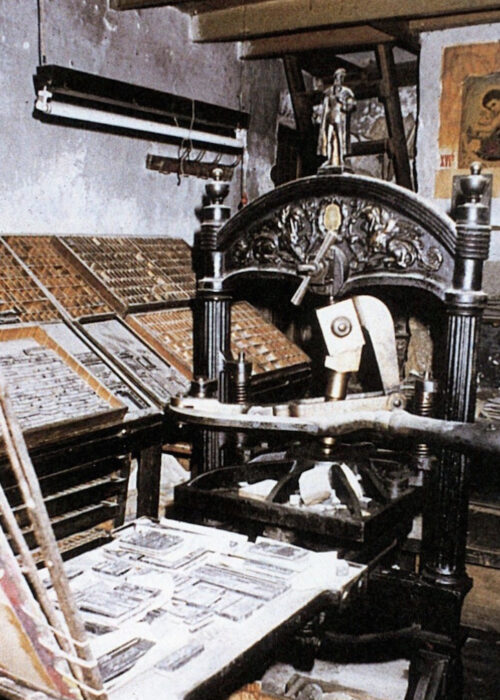27/4/2021
Printing Techniques

The Lithography technique
1796, Munich. The Bavarian writer Alois Senefelder discovered that he could easily and cheaply print his work using limestone, which is porous and water-retaining. In his experiments, he found that when he wrote with a specific kind of wax paint on liquid limestone, the water did not affect the "written" area of the plate. Then, with a roller, he applied greasy ink on the plate. The result? The ink was spread just on the areas of limestone, that had been previously designed with the paint. Then, by pressing the surface of the paper on the plate, you could see the pre-designed image being imprinted. The technique of lithographic printing flourished in the 19th century, but started to fade during 1935, when new methods created the era of offset lithography.
Metal Movable type
The creation of the first metal movable type: the letter was engraved on a piece of metal with a sharp instrument and was used as a mold, where molten liquid metal was poured into. All the letters of the alphabet were produced like that and were then placed together, with the help of special tweezers. The spaces between the words were created by adding metal components that did not have letters on them. When an entire page was complete, it was held in place by a string.
The Linotype
To deal with the mass production of forms, automated component-positioning methods were developed: linotype and monotype. The linotype machine was invented in 1884 by Osmar Mergenthaler. For about 80 years, it was a basic typewriter, ensuring multiple production over the handwriting system. In recent years, the spread of monotype and especially the appearance of photosynthetic printing, have limited the use of linotype.
The Monotype
A typewriting method with individual components (characters) instead of a solid line, as in linotype. The first monotype machine was built in 1887 by the American Talbert Lanston. The monotype typing system is particularly suitable for producing books that include symbols and numbers. Compared to linotype, it has the advantage of correcting without rearranging the entire series.
The Photosynthetic method
The selection and projection of all components of a text in a photographic film, which are then reproduced and compose an exact copy of the original. The first photocopiers appeared in 1945. The era of computer typography began in the late 1960s. Today, computer-programmed typing has prevailed.
With the photosynthetic method, text is typed on a photocopier and at the same time defined by the operator in terms of size and font. This text is then printed on a paper ribbon, which the bookmaker adjusts to the page size of the form. The page is photographed and displayed on polyester paper or film. This film is then used for offset printing.
The typographic method (letterpress printing)
Typographers had their data in "boxes", which had separate cases for each type of letter.
They formed the desired words by taking separate components and placing them together in a case. When several rows were placed, they moved them on a counter until other pages were prepared. The printing material was placed in a metal frame with strips and wooden wedges, to hold it firmly in place. Then, it was placed in the press, the components were inked and a sheet of paper was pressed on. Today, this method of traditional typography is almost extinct.
The Rotary Printing method
The principle of the roller press: The material about to be printed is transferred to one or more rollers. When these rollers are inked, the print is transferred on paper, as it directly comes in contact with them, while they rotate.
The Offset Method
Offset printing is a printing method used to reproduce text and images, but not in the usual way. It uses a photochemical process. Texts are first photographed on a special film, which is then placed on a photosensitive plate, exposed to light. This way, the text of the film is photochemically transferred to the lithographic plate, which holds the ink at the desired points, while points that are meant to stay blank, hold only water. The contents of the plate are then transferred to a rubber roller, which finally prints the paper.
The Table Printing Method
With the help of a desktop printing software (DTP software) authors and designers can create books, newspapers and magazines on the screen of a personal computer.
This software allows the designer to select the desired characters from a set of fonts, draw the pages on a computer screen, save them to a magnetic disk and then convert them to film for photosynthetic printing.
Source: tmth.gr
